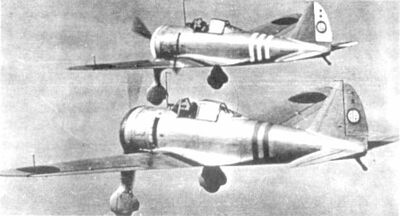The Nakajima Ki-27 or Army Type 97 Fighter (jap. 九七式戦闘機, 97-shiki sentōki), was the flag ship plane of

the Japanese Imperial Army Air Force from the year 1937 to 1942. In the year 1941 it was replaced by the Ki-43 Hayabusa.
History[]
In the year 1935, Japan began searching for a replacement for the Kawasaki Ki-10 biplane fighter. Nakajima Hikōki´s design prevailed itself against the design by Kawasaki and the Air Force version of the Mitsubishi A5M.
The first flight was on 15th October 1936 and in the year 1937 it entered service with the Japanese Air Force. In comparison to western fighters of this time the Ki-27 had weak engines and seemed outdated because of its not retractable landing gear. But Nakajima had already made tests with retractable landing gears, however the Ki-27 wasn´t equipped with one.
Because of its low weight the aircraft was very manoeuvreable and it had a good rate of climb. The wing construction with a straight leading edge and tapered trailing edge was very successful and was used on all Nakajima fighters during World War II.
However even if it had this great manoeuvreability it had a slower top speed and worse rate of climb than competitive aircraft and it was too slightly armed (only two 7.7 mm machine guns).
In combat over Northern China it was able to hold air superiority until the appearance of the Chinese Polikarpov I-16 of Soviet production.
Over Malaysia and Burma, as well as over the Philipines, the Japanese fighters were able to to fight successful against superior western fighters, like the Brewster Buffalo, the Hawker Hurricane or the Curtiss P-40 of the American Volunteer Group.
The main reasons for the Ki-27´s success were more experienced Japanese pilots and numerical superiority, so that it was replaced at the end of the year 1941 by the Ki-43 "Hayabusa". The remaining aircraft were used as trainers, till they were used at the end of 1944 for Kamikaze-suicide missions, in which it was equipped with up to 500 kilograms of explosives. It received the allied nickname "Nate" in the year 1942.